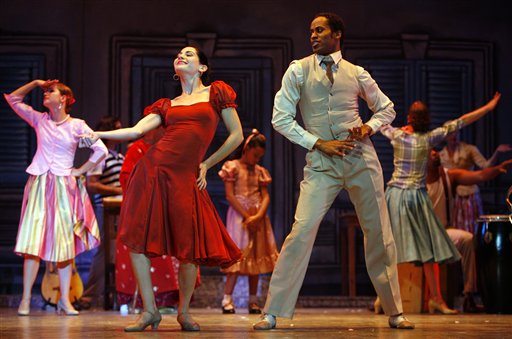Dance company offers refined Spanish flamenco with Cuban rhythm, flavor

Cuban flamenco dancers perform during the debut of “Vida” or “Life,” at the Mella theater in Havana, Friday, Jan. 18, 2008. “Vida” mixes flamenco and African-influenced styles that reflect the multicultural roots of the island. Dado Galdieri, The Associated Press
Feb 14, 2008
Last updated on May 12, 2016 at 09:30 p.m.
HAVANA – Their costumes are typically Spanish – refined dresses complemented with hand-held fans, painted faces and sculpted hair styles. But these dancers are clearly Caribbean, and while the music conjures up images of the Iberian peninsula, their moves have an undeniably Cuban sensuality, with the drumming of an island rumba driving the beat.
This is “Vida,” or “Life,” a Cuban-Canadian production by the Lizt Alfonso Dance Company that mixes the furious but refined rhythmic heel tapping of Spanish flamenco with the edgy, rustic and sexy traditions of Cuba’s African roots.
Classical flamenco is a wonderful tradition for Spain, but in Cuba, “it’s not worth imitating when you can do something authentic,” Alfonso explains after leading dancers through an exhausting rehearsal at her dance company’s Old Havana headquarters.
“In Cuba, there is an excellent school of (classic) ballet. They love Spanish dances and all kinds of folklore,” said Alfonso, who has soft features but penetrating eyes. “What I did was mix all that to create the type of dance we do, fusion.”
Get The Daily Illini in your inbox!
The show reflects a flamenco boom that swept Cuba after the Soviet Union’s collapse crippled the island’s economy in the early 1990s. Some Cubans later embraced flamenco as a sign of wealth and economic status, and many Spanish dance companies have sprung up around the country since then.
But Alfonso’s group is one of only a few companies able to truly embrace flamenco, pulling off “a very serious effort to renovate, reapportion and reinterpret its legitimate Iberian roots,” according to Cuban art critic Pedro de la Hoz.
“Vida” opened to critical acclaim last year in Canada, where private financing from a theater producer helped design and pay for costumes and sets that Alfonso managed to bring back to Cuba. The show is slated to run one month at Havana’s Mella Theater, but Alfonso hopes to extend performances well into the rest of the year.
A dancer as well as director, Alfonso attended her first ballet class at 4 and was performing on stage by age 9. A graduate of Cuba’s Superior Institute of Art, she was just 23 when she founded her own company in 1991, saying that working independently from government influence was the only way she could try new twists on Cuban classical ballet.
For years, the group was viewed with suspicion by Cuban authorities because it was not state-run. Some also bristled at Alfonso’s penchant for pioneering variations to classic Cuban dance forms.
“When you are born in an independent manner, no one can clip your wings,” Alfonso said. “We worked very hard, but for nine years we were considered something that shouldn’t exist.”
Alfonso does not appear personally in this show, which tells the story of Vida, an old woman who recounts her life’s story to her young granddaughter.
The narrative parallels 100 years of Cuban history, from colonialism to independence to Fidel Castro’s revolution and a communist government. At times, more than 50 performers crowd the stage. The performance “is our way of expressing what we feel, who we are and what we do,” Alfonso said.
The cast includes X Alfonso, a noted Cuban hip hop artist and Afro-rock singer not related to Lizt Alfonso, and Omara Portuondo, a diva of “Buena Vista Social Club” fame. Litz Alfonso said Portuondo, whose father was a black baseball player and whose mother came from a well-to-do white family, embodies the show’s mulatto spirit.
She said Vida embodies her dance company’s continuing effort to combine classic ballet with flamenco and raw Afro-Cuban emotion. Alfonso instructs her dancers to offer the audience “a sweeping of the feet, a Spanish tap dance, but with a coordination between arms and feet that adheres to the classic Cuban school.”
“We move our hands like it’s a flamenco, but we move our hips as if we were any Cuban, doing a rumba,” she said.
Alfonso’s company also breaks with what she calls the carefully choreographed “pendular” style of traditional flamenco, allowing dancers to move in ever-changing circles that are “passionate and almost out of control,” she said.
Though it quickly built a national following, Alfonso’s company faced resistance until it performed overseas. It was during a tour of Spain in late 1998, visiting 22 cities and provinces that Alfonso began perfecting her vision of flamenco fusion. She called it a “trial by fire.”
“The people who know flamenco better than anyone in the world, Spanish dancers, said to us ‘you are doing the same thing (we do), but your style is different,'” Alfonso recalled.
At first, the company could afford international tours only when organizers covered travel and logistical expenses. But a bit more than a year after the company’s success in Spain, Cuba’s Ministry of Culture came up with financial support for its expenses and performers’ salaries.
Some Cuban officials still oppose her company and its work, Alfonso says, but “when you do things in an authentic manner, you earn the right to be and others respect you.”





